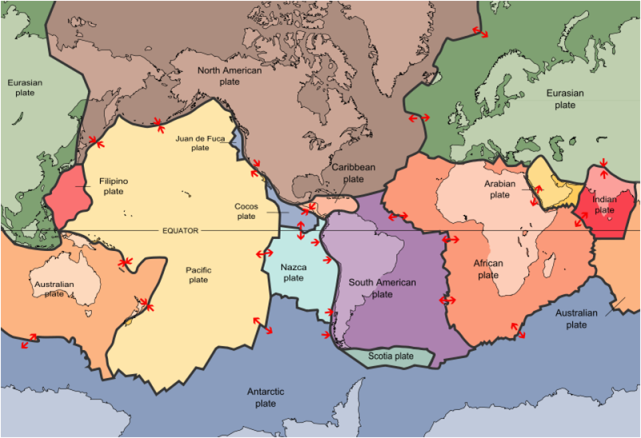SCIENCE QUARTER 1: EARTH AND SPACE
Module 1: Tectonic Plates
The movement of tectonic plates is responsible for various geological phenomena, including earthquakes, volcanic activity, and the formation of mountain ranges.
LITHOSPHERE is the outermost layer of the Earth that is made up of crust and upper mantle.
Two main types of crust:
Continental Crust - This is the thicker, lighter, less dense crust that makes up the continents and is composed mainly of granite.
Oceanic Crust - This is the thinner, heavier, denser crust that forms the ocean floors and is primarily composed of basalt.
7 major tectonic plates: These plates float on the semi-fluid asthenosphere and include the Pacific Plate, North American Plate, Eurasian Plate, African Plate, South American Plate, Antarctic Plate, and Indo-Australian Plate.
Plate Tectonic Theory explains the movement of these plates.
We can locate earthquakes using seismic waves. The different waves travel at varying speeds through different materials in the Earth, with primary (P) waves being the fastest and secondary (S) waves arriving later.

Module 2: Types of Plate Boundaries
There are three main types of plate boundaries:
Divergent boundaries: where tectonic plates move apart from each other.
Convergent boundaries: where plates collide, resulting in subduction, mountain building, or volcanic activity.
Transform boundaries: where plates slide past each other horizontally.
Asthenosphere : The semi-fluid layer of the Earth's mantle that allows tectonic plates to move over it.
Convective currents is the movement of the heat from the inner core to the mantle and then cooler areas in the mantle to go down to the inner core.
Types of stress:
Tension: the stress that occurs when plates pull apart, leading to stretching and thinning of the Earth's crust.
Compression: the stress that occurs when plates push together, causing shortening and thickening of the crust.
Shear: the stress that occurs when plates slide past one another, resulting in twisting or tearing of the crust.
Module 3: Different Processes in the Plate Boundaries
Divergent Boundaries: Occur where tectonic plates move away from each other, creating new crust as magma rises to the Earth's surface.
Convergent Boundaries: Found where plates collide, leading to one plate being pushed beneath another in a process known as subduction.
Transform Boundaries: Formed when plates slide horizontally past one another, often leading to earthquakes along fault lines.
Module 4: Possible Causes of Plate Movements
Mantle Convection currents: warm mantle currents drive and carry plates of lithospere along like a conveyor belt.
Slab Pull: This force occurs when an older, denser oceanic plate sinks into the mantle at a convergent boundary, pulling the rest of the plate along with it.
Ridge Push: At mid-ocean ridges, the formation of new crust pushes older crust away from the ridge, contributing to plate movement.
Continental drift theory of Alfred Wegener states there was once a supercontinent called Pangea. The surrounding body of water was called Panthalassa.
Seafloor spreading - hot magma rises, the magma cools down and becomes the new seafloor as it pushes the former.
Module 5: Evidence that Support Plate Movement
The Earth’s Mechanism
Continental Drift Theory
Evidence: The Continental Jigsaw Puzzle - Some of the continents can be fitted together like jigsaw puzzles.
Evidence: Fossils - Fossils were found on separate continents and nowhere else, suggesting the continents were once joined.
Evidence: Rocks - Some belts of rocks from different continents match when the ends of the continents are joined.
Evidence: Coal Deposit - Coal forms from ancient plant matter in warm, swampy environments, and the presence of coal deposits in regions that are now far from the equator indicates these areas were once located in different climates.
The Magnetic Reversal: a process where the Earth's magnetic poles switch places, with magnetic north becoming aligned with geographic south and vice versa. This helps scientists first identify the process of seafloor spreading.
The age of rocks and the magnetic stripes in the ocean floor support the Seafloor Spreading Theory.